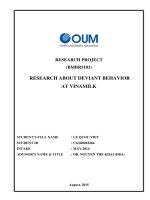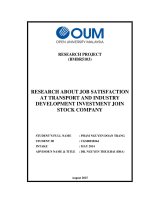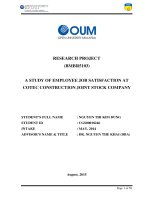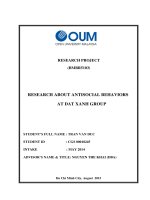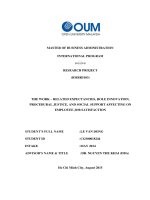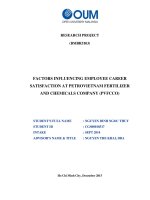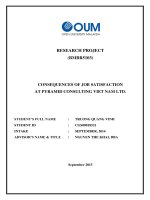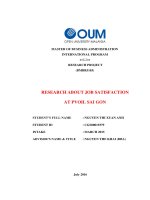Research about job satisfaction at petrovietnam drilling company
Bạn đang xem bản rút gọn của tài liệu. Xem và tải ngay bản đầy đủ của tài liệu tại đây (1.57 MB, 57 trang )
RESEARCH PROJECT
(BMBR5103)
RESEARCH ABOUT JOB SATISFACTION
AT PETRO VIETNAM DRILLING COMPANY
STUDENT’S FULL NAME
: HUYNH TRAN ANH THU
STUDENT ID
: CGS00019905
INTAKE
: SEPTEMBER 2015
ADVISOR’S NAME & TITLE
: DBA. NGUYEN THE KHAI
HCMC, March 2017
Advisor’s assessment
............................................................................................................................................
............................................................................................................................................
............................................................................................................................................
............................................................................................................................................
............................................................................................................................................
............................................................................................................................................
............................................................................................................................................
............................................................................................................................................
............................................................................................................................................
............................................................................................................................................
............................................................................................................................................
............................................................................................................................................
............................................................................................................................................
............................................................................................................................................
............................................................................................................................................
............................................................................................................................................
............................................................................................................................................
............................................................................................................................................
Advisor’s signature
Page 1
ACKNOWLEDGEMENTS
I would like to sincerely thank all HUTECH and OUM lecturers for their imparted
basic knowledge throughout MBA program.
Especially, I would like to express my gratitude to Dr. Nguyen The Khai for his
patience and encouragement during my research. Without his conscientious
instruction, I am unable to complete this research.
I would like to express my thanks to employees of Petro Vietnam Drilling Company
for their valuable time to answer my questionnaire.
I would like to thank my entire classmate each of whom has a unique contribution
that cannot be expressed in words.
I would like to thank my wife for her continuous patience and support throughout
the research. Without her nothing would be as good as it is.
Finally, I would like to express my special thanks to my family for their endless
encouragement throughout my education life and endless love throughout my life.
Huynh Tran Anh Thu
Page 2
TABLE OF CONTENTS
FIGURE AND TABLE ...............................................................................................6
ABBREVIATION .......................................................................................................6
ABSTRACT ................................................................................................................7
CHAPTER 1 INTRODUCTION ................................................................................8
1.1.
Company in brief ...........................................................................................8
1.1.1.
History .................................................................................................8
1.1.2.
Vision and mission ..............................................................................9
1.1.3.
Organization structure .........................................................................9
1.1.4.
Contact information ...........................................................................10
1.2.
Research problem statement ........................................................................11
1.3.
Purpose of the research ................................................................................11
1.4.
Scope of the research ...................................................................................12
CHAPTER 2 LITERATURE REVIEW ...................................................................13
2.1.
Construct definition .....................................................................................13
2.1.1
Job Satisfaction .....................................................................................13
2.1.2
Organization Commitment ...................................................................17
2.1.3
Work-Control ........................................................................................20
2.1.4
Job Stress ..............................................................................................21
2.1.5
Person-Organization Fit ........................................................................22
Page 3
2.2.
Relationship between constructs .................................................................24
2.2.1
Relationship between organization commitment and job satisfaction .24
2.2.2
Relationship between work-control and job satisfaction ......................24
2.2.3
Relationship between job stress and job satisfaction ............................25
2.2.4
Relationship between person-organization fit and job satisfaction ......26
2.3.
Summary of hypotheses...............................................................................26
2.4.
Conceptual research model ..........................................................................27
CHAPTER 3 RESEARCH METHODOLOGY .......................................................28
3.1.
Research procedure......................................................................................28
3.2.
Sampling method .........................................................................................28
3.3.
Data collection .............................................................................................29
3.4.
Data processing method and evaluation criteria ..........................................29
3.5.
Questionnaire ...............................................................................................32
3.5.1.
Likert scale definition ........................................................................32
3.5.2.
Scale level ..........................................................................................33
3.5.3.
Questionnaire .....................................................................................33
3.6.
Research participants ...................................................................................35
3.7.
Working schedule ........................................................................................36
CHAPTER 4 RESEARCH FINDING AND ANALYSIS ........................................37
4.1.
Reliability statistics......................................................................................37
4.2.
Descriptive statistics ....................................................................................37
4.3.
Correlations .................................................................................................38
Page 4
4.4.
Hypothesis testing results ............................................................................39
CHAPTER 5 CONCLUSION AND RECOMMENDATION .................................41
5.1.
Main finding and managerial implication ...................................................41
5.2.
Limitation and recommendation ..................................................................42
REFERENCE ............................................................................................................44
APPENDIX ...............................................................................................................46
Appendix 1: Survey questionnaire ............................................................................46
Appendix 2: Presentation ..........................................................................................52
Page 5
FIGURE AND TABLE
Figure 1: PVD Organization chart ............................................................................10
Figure 2: PVD Drilling Rig .......................................................................................12
Figure 3: Maslow's hierarchy of needs .....................................................................14
Figure 4: Job Characteristics Model .........................................................................16
Figure 5: Herzberg’s motivator-hygiene theory........................................................17
Figure 6: Conceptual research model ........................................................................27
Table 1: Cronbach's Alpha Internal Consistency ......................................................29
Table 2: Correlation value and relationship ..............................................................30
Table 3: Survey schedule ..........................................................................................36
Table 4: Cronbach's Alpha results ............................................................................37
Table 5: Descriptive Statistics ...................................................................................38
Table 6: Correlations statistics ..................................................................................38
Table 7: Model summary ..........................................................................................39
Table 8: Coefficient...................................................................................................39
ABBREVIATION
PVD:
PetroVietnam Drilling
JCM: Job Characteristic Model
MPS:
Motivation Potential Score
WC:
Work Control
OC:
Organization Commitment
JS:
Job Stress
POF:
Person-Organization Fit
JSI:
Job Satisfaction
SPSS:
Statistical Package for Social Science
Page 6
ABSTRACT
This study aimed to examine the impact of organization commitment, work-control,
job stress and person-organization fit on job satisfaction in Petro Vietnam Drilling
Corporation (PVD). The sample consisted of 296 onshore employees as participants
selected from head quarter in Ho Chi Minh City and subsidiaries in Vung Tau to
analyze the reliability and validity of each hypothesis. Collected data was used to
determine significant relationship between variables. The results indicated that
organization commitment, work-control and person-organization fit were positively
correlated with job satisfaction whereas job stress was not negatively correlated
with job satisfaction. The research findings will assist the organization to have
strategy on improving of human resource management.
Key words: organization commitment, work-control, job stress and personorganization fit, job satisfaction
Page 7
CHAPTER 1 INTRODUCTION
1.1.
Company in brief
1.1.1. History
Petro Vietnam Drilling Corporation (PVD), a member of Vietnam Oil and Gas
Group (Petro Vietnam), was founded on 26 Nov 2011. The company is a
professional provider of drilling rigs and related onshore and offshore services in
Vietnam. Over the last decade, PV Drilling has possessed a new modern generation
rig fleet including four jack-up rigs (PVD I, II, III, VI), one Tender Assist Drilling
Unit (PVD V) and one land rig (PVD XI). Owning six drilling rigs, PV Drilling has
developed significantly and become one of the leading subsidiaries of Petro
Vietnam and a prestigious contractor in the local and regional market for 15 years.
PV Drilling is rapidly expanding areas of business activities including drilling
services, deep-water techniques, providing professional human resources, pipeline
inspection and technical services related of oil and gas production for Vietnam and
the world. These key services have greatly contributed to the development of PVD.
Along with professional competence and experience in the field of drilling and
wells services, PV Drilling is also one of the leading suppliers who can undertake
oil spill treatment thus the company contributes to protection marine environment in
Vietnam. The primary ingredient that made up the success of PV Drilling is the
dedicated and outstanding human resources who incessantly pursue knowledge and
perfection in mastering the technology, developing the services and creating added
values for clients. Therefore, PV Drilling always concentrates on building and
Page 8
developing a human resource with great competence and consider it as top priority
in the corporate strategy of development. To serve such purpose, PV Drilling
applies a suitable recruitment policy, a systematic career development plan as well
as a competitive compensation and benefits scheme for attracting, developing and
maintaining talents.
PVD always pursues business objectives as a provider of true customer service to
obtain the long-term goal as a leading oil and gas drilling services company in
Vietnam.
1.1.2. Vision and mission
Vision
To be an internationally reputable and reliable drilling contractor and drilling
related service provider in the oil and gas industry.
Mission
Becoming a leading regional drilling service provider and drilling contractor,
creating great value added for clients by delivering premium services at competitive
prices.
1.1.3. Organization structure
By the end of 2015, PVD has totally 2147 employees. This workforce comes from
12 divisions and 16 subsidiaries of corporation.
As per figure 1 below, the organizational structure of PV Drilling includes
functional divisions and its subsidiaries.
Page 9
After 5 years establishing, PVD was listed on HCMC Stock Exchange on 05 Dec.
2006. Starting with 600 billion at listed date, chapter capital of PV Drilling now is
3500 billion VND. PVD was one of the 20 strongest companies on stock market in
Vietnam from 2010 to June 2014. However stock price started sharply declined
since July 2014 due to incredibly decrease of crude oil price in the world.
Figure 1: PVD Organization chart
1.1.4. Contact information
Address : 4th Floor, Sailing Tower
No.111A Pasteur Street, Ben Nghe Ward, Dist. 1, HCMC
Tel : (848)39142012; 39142013
Fax : (848)39142 021; 39142022
Website : www.pvdrilling.com.vn
Page 10
1.2.
Research problem statement
Global crude oil prices have fallen sharply over the past two years, leading to
significant revenue shortfalls in many energy exporting nations.
Oil and gas
producers have managed drilling prospects and maximized lower capital budgets to
their highest return projects. The oil and gas industry in Vietnam is no exception to
this trend, with the rig count dropping on average domestically by 20% since 2015.
This drastic fall has triggered the significant cut off exploration & production
budget of all oil operators in the Vietnam. This crisis has negatively affected profit,
production capacity and job of employees in PVD Corporation recently.
In order to survive during this recession, besides cutting operational cost, improving
productivities and retaining employee is one of the most important factors that will
strongly effect on success of PVD. The Board of Directors recognized that an
increase in job satisfaction is directly related to an increase in productivity therefore
this survey is finding the factors to meet employee’ job satisfaction and keep
talented workforce for sustainable development of company.
1.3.
Purpose of the research
The main purpose of this research is to study how organization commitment, workcontrol, job stress and person-organization fit have influenced on job satisfaction in
PVD’s workforce. This research helps board of director to be fully aware of the
important of job satisfaction and have overall view of this context. In addition,
researched result is a valuable reference resource for board of directors, top
managers and human resource departments. They could adjust strategic policies to
Page 11
improve working environment, social welfare for the purpose to retain employees,
strongly improve productivities and significantly enhance employees’ loyalty and
engagement for company’s further development.
1.4.
Scope of the research
This research just focuses on job satisfaction of the employees in PVD based on
their working condition and current position. The survey is within onshore offices
and subsidiaries. It absolutely does not imply re-structuring, rotating and replacing
the employees. This survey was conducted from 1 Dec 2016 to 04 Mar 2017.
Figure 2: PVD Drilling Rig
Page 12
CHAPTER 2 LITERATURE REVIEW
2.1.
Construct definition
2.1.1 Job Satisfaction
Job satisfaction can be understood in terms of its relationships with other key
factors such as stress, overload at work, home-work interface and organizational
working conditions. I observed that people who have a high level of job satisfaction
tend to be more productive and become successful in their chosen careers.
Cranny, Smith & Stone (1992) generally defined that job satisfaction is an
employee’s affective reaction to job based on comparing actual outcomes with
desired outcomes. It is generally recognized as a multifaceted construct that
includes employee feelings about a variety of both intrinsic and extrinsic job
elements (Howard &Frink, 1996). Porter and Steers (1973) argued that the extent of
employee job satisfaction reflected the cumulative level of met worker expectations.
That is, employees expect their job to provide a mix of features (pay, promotion,
autonomy) for which the employee has certain preferential values. The range and
importance of these preferences vary across individuals but when accumulation of
unmet expectation becomes sufficiently large there is less job satisfaction and
greater probability of withdrawal behavior (Pearson, 1991). Indeed, some interest in
job satisfaction is focused primarily on its impact on employee commitment,
absenteeism, intention to quit and actual turnover (Agho, Mueller & Price, 1993).
Job satisfaction theories have a strong overlap with theories explaining human
motivation.
Page 13
The most common and prominent theories in this area include: Maslow’s needs
hierarchy theory; Herzberg’s motivator-hygiene theory and the Job Characteristics
Model.
+ Maslow’s needs hierarchy theory
Although commonly known in the human motivation literature, Maslow’s needs
hierarchy theory was one of the first theories to examine the important contributors
to job satisfaction. It is a theory in psychology proposed by Abraham Maslow. He
published his "A Theory of Human Motivation" in Psychological Review in 1943.
Maslow subsequently extended the idea to include his observations of human's
innate curiosity. His theory parallel many other theories of human developmental
psychology, some of which focus on describing the stages of human growth.
Theory suggests that human needs form a five-level hierarchy consisting of:
physiological needs, safety, belongingness/love, esteem, and self-actualization.
Figure 3: Maslow's hierarchy of needs
Page 14
Maslow’s needs hierarchy was developed to explain human motivation in general.
However, its main tenants are applicable to the work setting and have been used to
explain job satisfaction. Within an organization, financial compensation and
healthcare are some of the benefits which help an employee meet their basic
physiological needs.
+ Job Characteristic Model
The Job Characteristics Model (JCM), developed by organizational psychologists
J.Richard Hackman and Greg Oldham, is a normative approach to job enrichment. It
specifies five core job dimensions that will lead to critical psychological states in
the individual employee. The first three dimensions are:
(a) Skill variety (the range of tasks performed)
(b) Task identity (the ability to complete the whole job from start to finish)
(c) Task significance (the impact of the job on others).
These three dimensions contribute to the meaningfulness of the work. In other
words, the higher the task variety, identity, and significance, the more meaningful
the work is to the employee.
The fourth job dimension is autonomy (the extent of discretion and freedom an
employee has over his or her tasks). The higher this is, the more the employee feels
responsible for the outcome of his or her work.
The fifth dimension is feedback (the extent to which the job provides the employee
with information about the effectiveness of his or her performance) which allows
the employee to appreciate the outcome of his or her efforts. As a consequence of
Page 15
providing positive psychological states, the Job Characteristics Model suggests that
positive outcomes will occur for the individual and the organization: high
motivation, high-quality performance, high job satisfaction, low absenteeism, and
low labor turnover. The model is used to assess the motivational potential of
particular jobs and thereby suggest which of these jobs could be redesigned. To do
this, a motivational potential score (MPS) is calculated from a questionnaire
consisting of the components of the JCM. The score is an index based on the
following formula:
MPS = ((Skill variety + task variety + task significance)/3) × autonomy × feedback
Figure 4: Job Characteristics Model
+ Herzberg’s motivator-hygiene theory
Herzberg's motivation-hygiene theory, also known as the two-factor theory or dualfactor theory, states that there are certain factors in the workplace that cause job
satisfaction, while a separate set of factors cause dissatisfaction. It was developed
Page 16
by psychologist Frederick Herzberg, who theorized that job satisfaction and job
dissatisfaction act independently of each other.
Attitudes and their connection with industrial mental health are related to Abraham
Maslow's theory of motivation. His findings have had a considerable theoretical, as
well as a practical, influence on attitudes toward administration. According to
Herzberg, individuals are not content with the satisfaction of lower-order needs at
work. Rather, individuals look for the gratification of higher-level psychological
needs having to do with achievement, recognition, responsibility, advancement, and
the nature of the work itself. This appears to parallel Maslow's theory of a need
hierarchy.
Figure 5: Herzberg’s motivator-hygiene theory
2.1.2 Organization Commitment
Commitment is a very multidimensional concept and therefore somewhat hard to
define. Commitment has been studied much, and it still remains one of the most
challenging and researched in the fields of management, organizational behavior
Page 17
and human resource management (Cohen 2007, 336). There has been numerous
ways to define commitment in the past years and researchers from different fields
like to emphasize different aspects of it (Jokivuori 2001, 17). Often commitment is
seen as a force that binds individual to a course of action that is relevant to one or
more targets (Cohen 2003, IX). Those targets can be directed to people, for example
family or friends as well as to various institutions, like sports, community groups or
work organization (Heery & Noon 2001, 91).
Like it is hard to comprehensively define commitment as such, the same difficulty
is for organizational commitment. However, it has been possible to find common
factors to various definitions. Common to all of these conceptualizations is a
connection with turnover; employees who are strongly committed are those who are
least likely to leave the organization (Allen & Meyer 1990, 1).
Organization commitment can be defined as an individual's psychological
attachment to the organization. Organizational commitment plays a very important
role in determining whether a member will stay with the organization and zealously
work towards organizational goals.
Commitment in the workplace has been quite widely studied since 1950’s (Cohen
2003). On the other hand, there is quite rational reason since organizational
commitment is connected to many things we consider important such as work
satisfaction, sickness related absences and willingness to change job, etc.
There are some different models used to conceptualize organizational commitment.
Page 18
+ O’Reilly and Chatman’s model
O’Reilly and Chatman (1986) see organizational commitment as a psychological
attachment to an organization. According to Ruokolainen (2011, 15) it reflects “the
degree to which employee internalizes or adopts the characteristics or perspectives
of the organization”. Commitment can be formed by three independent
mechanisms: compliance, identification and internalization.
Compliance is the shallowest of them all and is connected to rewards. Person adopts
certain attitudes and behaviors in order to gain specific awards.
Identification is step further into deeper commitment. Employee feels proud to be
part of that specific organization and thus accepts and respects its’ values and
accomplishments. He or she wants to establish or maintain good relationship with
that specific group. However, what separates that from the internalization is that he
or she does not adapt those values as his or her own. Therefore, internalization
occurs finally when there is value congruence between the person and the
organization.
However, there have been few matters that have received critique in this model.
Internalization and identification correlate positively with intend to stay with an
organization, while compliance acts in the opposite way actually correlating
positively with turnover.
+ Three-component model of commitment
One of the most widely used theories in organizational commitment is threecomponent model of Allen and Meyer’s (1990). It has been the leading approach in
Page 19
studying organizational commitment for more than 20 years (Cohen 2007, 337).
Lately, it has been the most widely accepted conceptualization of organizational
commitment (Herr Bach 2006, 631). It sees commitment as having three separable
forms: affective, continuance, and normative commitments.
Affective commitment is your emotional attachment to an organization. If you have
a high level of affective commitment, you enjoy your relationship with the
organization and are likely to stay. You stay because you want to stay.
Continuance commitment is the degree with which you believe that leaving the
organization would be costly. If you have a high level of continuance commitment,
you will stay with an organization because you feel that you must stay. For
example, you may feel quitting your job may lead to an unacceptable length of
unemployment. On the other hand, you may feel you will lose a certain degree of
status if you leave a well-respected organization such as a top law firm or research
company.
Normative commitment is the degree you feel obligated to the organization or
believe that staying is the right thing to do. Here, you believe you ought to stay.
2.1.3 Work-Control
Control is a term in psychology that refers to a person’s belief about what causes
the good or bad results in his or her life either in general or in a specific area such as
health or academics. It also refers to an individual’s generalized expectations
concerning where control over subsequent events resides. According to many
Page 20
researchers the type of locus of control an individual carries has an effect on level of
job satisfaction (Lakshman & Mali, 2011).
Work control is defined as “having influence over the work environment, including
ability to influence the execution and the planning of work tasks” (Mark et al.,
2006). Work control was found to buffer the effects of workload on stress and of
acute strains on musculoskeletal symptoms; while rest breaks received less
consistent support as a moderator variable (Burnfield, 2005). Evidence is growing
that enhanced control at work can be an important element in employees’ health and
well-being (Paul, 2002). Employees with low control can become frustrated and feel
underappreciated (Medibank, 2008).
2.1.4 Job Stress
According to National Institute of Occupational Safety and Health of United States
in 1999, job stress is defined as the harmful physical and emotional responses that
occur when job requirements do not match employees’ capabilities, resources and
needs. It is recognized world-wide as a major challenge to individual mental and
physical health and organizational health (ILO 1986). Stressed workers are also
more likely to be unhealthy, poorly motivated, less productive and less safe at work.
Their organizations are less likely to succeed in a competitive market. By some
estimates work-related stress costs the national economy a staggering amount in
sick pay, lost productivity, health care and litigation costs (Palmer et al. 2004).
Job stress can come from a variety of sources and affect people in different ways.
Although the link between psycho-social aspects of the job and the health and well-
Page 21
being of workers has been well documented (Dollard and Metzer 1999), limited
work has been done on the effects of distinct stressors on job performance. As well,
various protective factors can prevent or reduce the effects of work stress, and little
research has been done toward understanding these mitigating individual and
organizational factors.
There are many studies which specifically addresses to the concerns of job stress
and their consequences. Stress can strongly evoke the negative emotions like fear,
frustration, sadness, and anger (Cavanaugh, 1988). Job stressors such as workload,
working conditions, and expectation from management cause strain (Behr & Glazer,
2001) and can significantly lead to anxious feeling, less productivity and poor
health of employees.
The researcher found in this study that stress in job due to different issues like work
overload, coworkers behavior, etc. become harmful not for himself but for the
organization which negatively affected the job satisfaction. This stress can be
reduced by appraisal plans, fix day to day plans, giving training, orientation, proper
pay package equal employee opportunities. These thing reduce the employee stress
and ultimately increased the employee job satisfaction (Obiora & Iwuoha, 2013).
2.1.5 Person-Organization Fit
Person-organization fit is considered as a topic of great interest in the disciplines of
organizational behavior and human resource management. In simple words personorganization fit is defined as measure of fit among workers and the organizations
(Silverthorne, 2004). In a broader view, it is defined as matching between
Page 22
distinctive characteristics of the employee and the organization in which that
employee is working. Person-organization fit is a construct that has multiple
conceptualizations (Westerman & Cyr, 2004b). Moreover, it is evaluated by
matching the personality of the individual worker with his or her organization
(Cable & Judge, 1996). Person-organization fit is the compatibility of
characteristics of the individual and that of organization (Chan, 1996). Individual
characteristics include individual’s ideas, principles, interests and dispositional
characteristics while organizational characteristics are made of organizational
doctrine, norms, traditions and the overall organizational climate. Personorganization fit is the level of compatibility that exists between worker and
organizations when at the minimum level one entity holds responsible for providing
what the other want and prefers (Kristof, 1996). This compatibility is of two types,
one is supplementary fit and the other is complementary fit (Kristof, 1996).
Supplementary fit means that personal characteristics of the individual employee
are harmonized with that of the organizational characteristics. If the workers
psychological needs are satisfied by the conditions of the workplace, then
complementary fit is achieved. If the employee is better fitted in the organization
through having supplementary or complementary fit then the employee will become
a satisfied employee (Bright, 2007; Kristof, 1996).
Page 23
2.2.
Relationship between constructs
2.2.1 Relationship between organization commitment and job satisfaction
The relationship between job satisfaction and organizational commitment is
important because employees often do not prefer to stay with the same organization
for long. It has become difficult for the organizations to exercise influence on the
employees to retain them. The most used research definition of job satisfaction is by
Locke (1976), which is as “a pleasurable or positive emotional state resulting from
the appraisal of one’s job or job experiences.”
Researchers have argued that satisfied employees are more committed to serving
customers (Loveman, 1998; Silvestro, 2000; and Yoon & Suh, 2003). The study
showed that satisfied employees are more likely to work harder and provide better
services via organizational citizenship behaviors (Yoon & Suh, 2003). Employees
who are satisfied with their jobs tend to be more involved in their employing
organizations, and more dedicated to delivering services with a high quality level
quality (Ayeni & Phopoola, 2007). Fernando, et al. (2005) found that organizational
commitment is positively correlated with job performance.
2.2.2 Relationship between work-control and job satisfaction
Judge and Bono (2011) found that there is a positive relationship between work
control and job satisfaction. Managers consider the most important sources of work
stress to be lack of control and work life balance (Gupta, Bindu, &Tyagi, 2009).
The perception of high work control buffers the negative effects of a stressful work
situation on an individual’s health and well-being. A great deal of evidence links
Page 24

